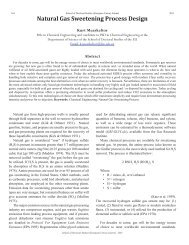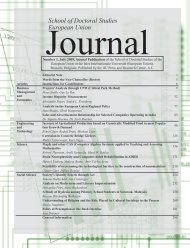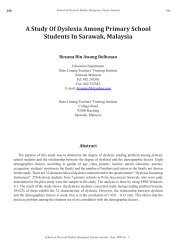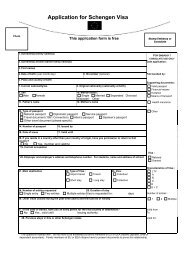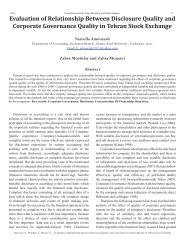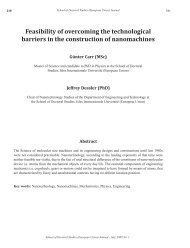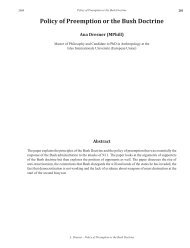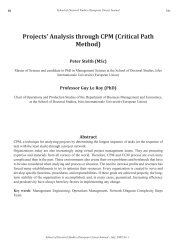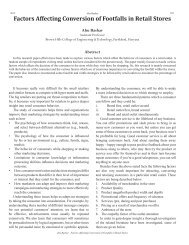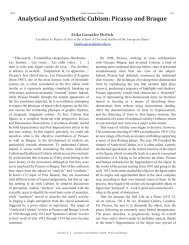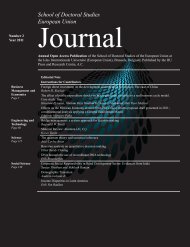Iiuedu.eu
Iiuedu.eu
Iiuedu.eu
You also want an ePaper? Increase the reach of your titles
YUMPU automatically turns print PDFs into web optimized ePapers that Google loves.
34 School of Doctoral Studies (European Union) Journal2011Customer loyalty expresses an intended behavior relatedto the service or the company. This includes the likelihoodof future renewal of service contracts, how likely it is thatthe customer changes patronage, how likely the customeris to provide positive word-of-mouth, or the likelihoodof customers providing voice. If real alternatives existor switching barriers are low, management discovers theorganization’s inability to satisfy its customers via twofeedback mechanisms: exit and voice (Hirschman, 1970).Exit implies that the customers stop buying the company’sservices while voice is customer complaints expressingthe consumers’ dissatisfaction directly to the company.Customers’ exit or change of patronage will have an impacton the long-term revenue of the company. Effects causedfrom changes in the retention rate are exponential (notlinear) with regard to effects on the long-term revenue.Even a marginal reduction/increase in retention rate hassignificant effects on future revenue (Andreassen, 1995;Reichel & Sasser, 1990).Three conceptual perspectives have been suggestedto define customer loyalty: the behavioral perspective,the attitudinal perspective and the composite perspective(Bowen & Chen, 2001: Zins, 2001). The behavioralperspective, “purchase loyalty”, strictly looks at repeatpurchase behavior and is based on the customer's purchasehistory. The emphasis is on past -rather than on- futureactions. Moreover, no other loyal behavioral actions suchas price tolerance, word of mouth, or complaint behaviorcan be interpreted (Zins, 2001). Concentrating on thebehavioral aspect of loyalty could overestimate true loyalty(Zins, 2001). The attitudinal perspective, in contrast, allowsgain in supplemental understanding of loyal behavior (Zins,2001). The customer loyalty is approached as an attitudinalconstruct. An Attitude denotes the degree to which aconsumer's disposition towards a service is favorablyinclined. This inclination is reflected by activities such asthe customers recommending service providers to otherconsumers or their commitment to repatronize a preferredservice provider (Gremler & Brown, 1996). Based on afavorable attitude towards a service provider, customersmay develop “preference loyalty” (De Ruyter, Wetzels& Bloemer, 1998). Lastly, the composite perspectivecombines attitudinal and behavioral definitions of loyalty.The composite perspective might be considered as analternative to affective loyalty since using both attitudeand behavior in a loyalty definition arguably increases thepredictive power of loyalty (Pritchard & Howard, 1997).Under all these conditions, protecting the existingcustomer base and retaining existing customer loyaltyappear to be the crucial competitive advantage. Customerloyalty is a key component for a brand's long-term viability(Krishnamurthi & Raj, 1991). Oliver (1991) defines itas “a deeply held commitment to re-buy or re-patronizea preferred product/service consistency in the future,thereby causing repetitive same-brand or same brand-setpurchasing, despite situational influences and marketingefforts of having the potential to cause switching behavior.”Though there are many more definitions of customer loyalty,it seems clear that there are two basic varieties: stochasticand deterministic. Fournier and Yao (1997) observe thatthere is a need for a complete definition of brand loyalty,identify six necessary conditions: a biased (i.e. random)behavioral response (i.e. purchase), expressed over timeby some decision-making unit, with respect to one or morealternative brands out of a set of such brands, as a functionof psychological processes (such as decision making orevaluation).No matter how customer loyalty is defined, in order togain it, any operator needs to:• Increase subscriber satisfaction by raising offeredservice quality (for example, Anderson and Sullivan,1993; Brady and Robertson, 2001; Kristensen,Martensen & Gronholdt, 2000; Fornell, Johnson,Anderson, Cha & Bryant, 1996; Oliver, 1980);• Ensure subscribers’ trust in the firm (see, for example,Fournier, 1998; Gundlach , Achrol & Mentzer, 1995;Morgan and Hunt, 1994; Lau and Lee, 1999); and• Establish a cost penalty for changing to another serviceprovider, making that a comparatively unattractiveoption (Fornell, 1992) and expand is application (Eber,1999; Jones, Beatty & Mothersbaugh, 2002; Bloemer,De Ruyter & Peeters, 1998; Lee, Lee & Feick, 2001).Customer Satisfaction and Customer LoyaltySeveral authors have found a positive correlation betweencustomer satisfaction and loyalty (Anderson & Sullivan,1993; Bearden & Teel, 1980; Bolton & Drew, 1991; Fornell,1992). Customers may be loyal because of high switchingbarriers or lack of real alternatives. Customers may alsobe loyal due to their satisfaction and thus want to continuethe relationship. History has proven that most barriers toexit are limited with regard to durability; companies tendto consider customer satisfaction the only viable strategy inorder to keep existing customers.Based on Coyne (1989), there are two critical thresholdsaffecting the link between satisfaction and loyalty. On thehigh side, when satisfaction reaches a certain level, loyaltySchool of Doctoral Studies (European Union) Journal - 2011



